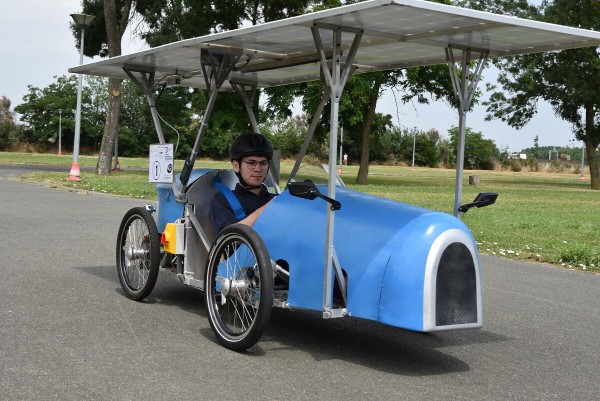Solar Challenge
Angers Solar Challenge is a solarpowered electric car rally organised by the IUT (University Institute of Technology). On 13 June, students in Mechanical and Production Engineering (GMP) were invited to drive 100 kilometres in four hours.

José, 2nd-year student of Mechanical and Production Engineering at the University Institute of Technology was one of the piloteslat the Angers Solar Challenge.
The meeting took place on the Baumette circuit, a stone's throw from the Sco d'Angers football training centre. The outside temperature was 23 degrees and the sky over Angers was a clear blue. A good omen for the participants in the Angers Solar Challenge, a rally that came into being in 2022.
For this 2nd edition, two challenges were organised: the first involved driving 100 kilometres in an solar-generated electric vehicle weighing 65 kilos. "Due to a lack of sunshine last year, we only reached 99.6 km", recalls Laurent Valette, a teacher at the University Institute of Technology and one of the co-organisers of the rally.
The new feature this year was the second challenge, made up of three events (slalom, sprint, endurance) completed using a small radio-controlled solar electric vehicle.
Already thinking about ideas for 2024
For four hours, two drivers took turns every forty minutes to complete a series of laps of the 400-metre La Baumette circuit. José, a 2nd year GMP student, enjoyed the experience: "It's a bit of a home-made type of driving, reminiscent of a soapbox car," he says. "It's very light and manoeuvrable at the same time. A lot of research has been done on this vehicle as part of our training, and it's interesting now to try and use only the energy produced by solar panels."
During the first hour of the race, clouds dotted the sky, allowing the vehicle to travel at "only" 18 km/h with an output of 100 watts. But later, in bright sunshine, the vehicle was able to reach peak speeds of 30 km/h, with more than 450 watts produced.
And after four hours of racing, from 12.20 pm to 4.20 pm, the verdict was in: 101 kilometres! "Despite the uncertain weather at the start, the challenge was a success," boasts Laurent Valette. "What's more, the vehicle produced 1,500 watts per hour and consumed 1,400: so the energy produced is greater than the energy consumed." The second challenge was another source of satisfaction, as two radio-controlled vehicles achieved their objectives.
In anticipation of the possible participation of the École nationale supérieure d'arts et métiers (Ensam) in next year's Angers Solar Challenge, the students are already working on the vehicle that will be used in 2024: 20% lighter, with a more efficient engine, three wheels instead of four, larger solar panels, etc. And sunshine all day long, of course!
